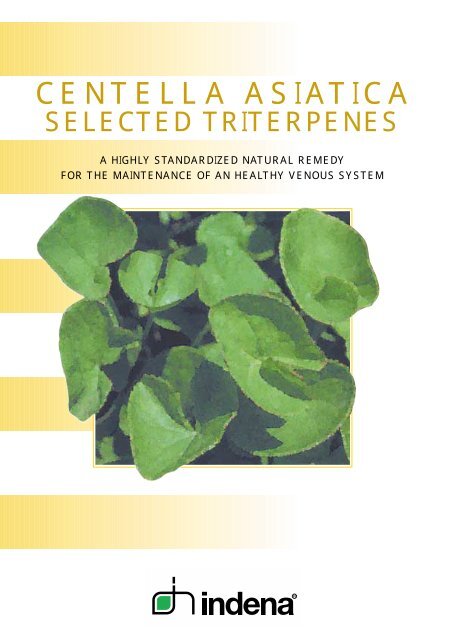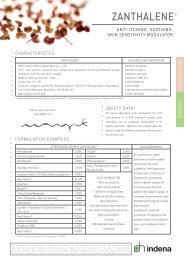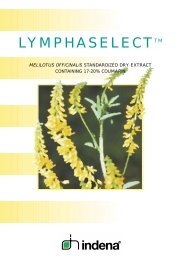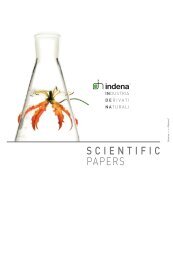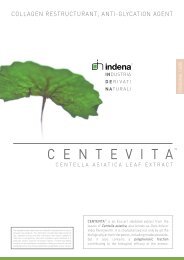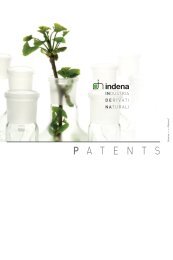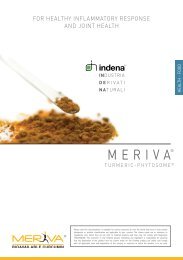Centella asiatica selected triterpenes - Indena
Centella asiatica selected triterpenes - Indena
Centella asiatica selected triterpenes - Indena
You also want an ePaper? Increase the reach of your titles
YUMPU automatically turns print PDFs into web optimized ePapers that Google loves.
CENTELLA ASIATICA<br />
SELECTED TRITERPENES<br />
A HIGHLY STANDARDIZED NATURAL REMEDY<br />
FOR THE MAINTENANCE OF AN HEALTHY VENOUS SYSTEM
Phytopreparations containing<br />
terpenes, flavonoids and<br />
coumarins have a good<br />
therapeutic potential as venoactive<br />
drugs and are widely used in the<br />
treatment of symptomatology<br />
associated with chronic venous<br />
insufficiency of the lower limbs. This<br />
illness causes severe injuries in the<br />
venous wall, metabolic alterations of<br />
the vascular and perivascular tissue<br />
and morphological and functional<br />
changes in the microcirculatory<br />
system. 1,2<br />
It is reported that an abnormally<br />
increased capillary permeability, due<br />
to damage to the endothelium, causes<br />
tissue edema and the leakage of<br />
plasma proteins such as fibrinogen.<br />
Fibrinogen, turned into fibrin, induces<br />
severe alterations in the metabolism<br />
and in the structure of the perivascular<br />
connective tissue, which may lead<br />
to the onset of venous ulcers and to a<br />
worsening of the illness (Fig. 1).<br />
An increase in resting blood flow, an<br />
impairment of the venoarteriolar<br />
reflex, and a decreased lymphatic<br />
clearance are the main functional<br />
changes in microcirculatory system.<br />
The total triterpenic fraction of<br />
C. <strong>asiatica</strong> leaves has been found to be<br />
effective for chronic venous<br />
insufficiency and varicosities, by<br />
improving microcirculation and the<br />
metabolic activity of the vascular and<br />
perivascular connective tissue.<br />
BOTANY AND HISTORY<br />
<strong>Centella</strong> <strong>asiatica</strong> (L.) Urb. (syn.:<br />
Hydrocotyle <strong>asiatica</strong> L.) of the Apiaceae<br />
(Umbelliferae) family is a small<br />
herbaceous perennial plant, native to<br />
India, China, Indonesia, Australia, the<br />
South Pacific, Madagascar, and southern<br />
and middle Africa. It grows preferably in<br />
damp swampy areas, up to 700 meters<br />
above sea level.<br />
This slender creeping plant has long,<br />
prostrate, filiform stems with long<br />
internodes, rooting at nodes. The longpetioled<br />
leaves, 1-5 in number from each<br />
node, are reniform, oval or orbicular,<br />
deeply cordate, 1-7 cm in diameter.<br />
The small, purple to white-green flowers,<br />
3-6 in number, are arranged in umbels<br />
arising from the axils of the leaves.<br />
The fruit is 8 mm long, ovoid, hard<br />
with strongly thickened pericarp. 3 Since<br />
ancient times C. <strong>asiatica</strong> has been used<br />
in traditional Indian medicine for<br />
various pathological disorders and in<br />
Fig. 1 Main target sites of <strong>Centella</strong> <strong>asiatica</strong>.<br />
particular for the healing of wounds<br />
and for leprosis.<br />
In the Ayurvedic system of medicine it<br />
is also recommended in chronic<br />
diseases and as a “brain tonic” in<br />
various mental disorders.<br />
The wound healing applications have<br />
also been known in the folk medicine<br />
of Malay Peninsula, Java and other<br />
islands, Madagascar, Kenya whereas<br />
the psychotropic application of<br />
C. <strong>asiatica</strong> has been known in China.<br />
It is listed officially in the Chinese<br />
Pharmacopoeia and used as an<br />
antipyretic and diuretic, and in the<br />
treatment of icterus, heatstroke,<br />
diarrhea, ulcerations, eczema, and<br />
traumatic diseases. 3-7<br />
Today preparations of C. <strong>asiatica</strong> leaves<br />
constitute the active principle of<br />
pharmaceutical and cosmetic products<br />
for the treatment of venous and skin<br />
disorders.<br />
PERIPHERAL CHRONIC VENOUS INSUFFICIENCY<br />
MICROANGIOPATHY<br />
MORPHOLOGICAL AND FUNCTIONAL DAMAGES<br />
IN MICROCIRCULATORY SYSTEM<br />
ENDOTHELIUM DAMAGE RESTING BLOOD FLOW<br />
INCREASED<br />
CAPILLARY PERMEABILITY<br />
EDEMA<br />
PLASMA PROTEIN<br />
LEAKAGE<br />
METABOLIC ALTERATION<br />
OF CONNECTIVE TISSUE<br />
ULCERATION<br />
➔<br />
VENOARTERIOLAR REFLEX<br />
➔<br />
LYMPHATIC CLEARANCE<br />
➔
CENTELLA ASIATICA<br />
SELECTED<br />
TRITERPENES<br />
<strong>Centella</strong> <strong>asiatica</strong> <strong>selected</strong> <strong>triterpenes</strong><br />
(CAST) is a standardized mixture<br />
of the most significant active principles<br />
of C. <strong>asiatica</strong> leaves<br />
(Extract / Drug ratio: ≅ 1/30),<br />
namely the glycoside asiaticoside<br />
(36 to 44%) and the genins asiatic<br />
and madecassic acid (56 to 64%),<br />
assayed by HPLC (Fig. 2).<br />
BIOLOGICAL ACTIVITIES<br />
The first experimental studies, carried<br />
out from the late 1950’s, highlighted<br />
that asiaticoside was endowed with a<br />
potent wound and ulcer healing<br />
activity. 3<br />
CAST and its components have been<br />
reported to facilitate the formation of<br />
wound tissue and enhanced the tensile<br />
strength of the newly made skin after<br />
local application on rat wounds. 8,9<br />
Poizot and Dumez 10 have reported that<br />
a standardized extract of C. <strong>asiatica</strong><br />
accelerated the healing of chronic<br />
wounds in rats after oral administration<br />
of 100 mg/kg.<br />
Later, in in vitro studies 11-16 on cultured<br />
human vein and skin fibroblasts, CAST<br />
and its triterpenic components were<br />
found to increase proline incorporation<br />
and stimulate collagen biosynthesis<br />
(Table 1). This finding has been<br />
Standardized extracts of C. <strong>asiatica</strong><br />
leaves and asiaticoside have been<br />
reported to be well tolerated in<br />
experimental animals especially by oral<br />
route. In toxicological studies<br />
asiaticoside did not show any sign of<br />
Fig. 2 Chemical structures of the CAST constituents.<br />
HO<br />
HO<br />
HOH2C HO<br />
HO<br />
HOH2C OH H<br />
H OH<br />
H HO<br />
C O H<br />
O H<br />
O<br />
CH2 O<br />
ASIATICOSIDE<br />
OH H<br />
H<br />
H HO O<br />
H<br />
O H<br />
CH2OH COOH<br />
ASIATIC ACID<br />
confirmed in vivo by Suguna et al. 17<br />
with an alcoholic extract of C. <strong>asiatica</strong><br />
leaves.<br />
Tenni et al. 16 have also reported that<br />
CAST (25 µg/mL) stimulated also the<br />
cell layer fibronectin on human skin<br />
fibroblast cultures.<br />
Fowst et al. 18 have reported that CAST<br />
(15-70 µg/mL) positively influenced the<br />
confluence rate of endothelial cells in<br />
toxicity up to the dose of 1 g/kg after<br />
oral administration, whereas the toxic<br />
dose by intramuscular application to<br />
mice and rabbits was 40 to 50 mg/kg. 3<br />
In teratological studies in rabbits, a<br />
standardized extract of C. <strong>asiatica</strong><br />
ASIATICOSIDE<br />
culture, and showed a stimulating<br />
activity on fibronectin and PGI 2<br />
production.<br />
CAST proved also to inhibit the platelet<br />
aggregation induced by collagen, ADP,<br />
and arachidonic acid.<br />
These results suggest that CAST may<br />
modulate the metabolism of connective<br />
tissue, favoring wound healing and also<br />
improving tissue microcirculation.<br />
Table 1 Effect of CAST on collagen and total protein synthesis in human skin fibroblasts.<br />
TOXICOLOGICAL AND PHARMACOKINETIC DATA<br />
MADECASSIC<br />
ACID<br />
HO<br />
HO<br />
HOH2C OH<br />
OH OH<br />
H<br />
H H<br />
H<br />
OH<br />
CH 3<br />
Total proteins Collagen<br />
(dpm x 10 -3 /plate) (%)<br />
Control 221 ± 26 8.40 ± 0.43<br />
CAST (25 µg/mL) 205 ± 32 11.38 ± 0.72 *<br />
COOH<br />
Total protein synthesis was determined as the radioactivity incorporated into non dialyzable molecules of the<br />
medium and cell layer; collagen percentage was calculated from the radioactivity of proline and hydroxyproline.<br />
* p
Fig. 3 Plasma concentrations of asiatic acid after oral administration of CAST<br />
in healthy volunteers.<br />
Plasma level (µg/mL)<br />
2.0<br />
1.5<br />
1.0<br />
0.5<br />
Table 2 Pharmacokinetic parameters.<br />
Parameter<br />
Single administration Chronic treatment<br />
0.0<br />
0 10 20<br />
Time (h)<br />
30<br />
0.0<br />
0 10<br />
Time (h)<br />
20 30<br />
30 mg 60 mg<br />
Table 3 CAST: main clinical studies performed between 1990-1994.<br />
Number Number of Dosage<br />
of patients (mg/day, p.o.) Results<br />
reference and diagnosis and duration<br />
28 20 60 serum uronic acids<br />
varicosities 3 months serum lysosomal enzymes<br />
29 62 90-180 capillary filtration rate<br />
postphlebitic syndrome 4 weeks and edema<br />
symptoms<br />
30 44 180 capillary permeability<br />
chronic venous 2 weeks and edema<br />
insufficiency symptoms<br />
31 50 120 improved microcirculation<br />
diabetic 6 months capillary permeability<br />
microangiopathy RF and PCO 2<br />
VAR and PO 2<br />
stops ulceration damage<br />
32 30 90<br />
postphlebitic syndrome 3 weeks<br />
33 19 120<br />
postphlebitic edema 3 weeks<br />
Single dose 7-day treatment<br />
30 mg 60 mg 30 mg 60 mg<br />
Cmax (µg/mL) 0.70 ± 0.11 1.36 ± 0.13 1.03 ± 0.05 1.69 ± 0.07<br />
t1/2 (h) 2.20 ± 0.30 3.40 ± 0.68 6.33 ± 1.82 10.28 ± 1.80<br />
AUC 0-24 (µg/mL•h) 4.16 ± 1.10 9.39 ± 1.02 10.47 ± 1.09 20.83 ± 1.27<br />
circulating endothelial cells<br />
LC/PC and distal edema<br />
34 87 60-120 improved microcirculation<br />
chronic venous 2 months RF and PCO 2<br />
insufficiency and PO2<br />
postphlebitic syndrome<br />
LC/PC = lymphatic protein concentration in the interstitial liquid/plasma protein concentration<br />
PO 2 = transcutaneous oxygen pressure<br />
PCO 2 = transcutaneous carbon dioxide pressure<br />
RF = resting blood flow<br />
VAR = venoarteriolar reflex<br />
Plasma level (µg/mL)<br />
2.0<br />
1.5<br />
1.0<br />
0.5<br />
a 7-day treatment (30 or 60 mg twice a<br />
day), following a randomized cross over<br />
design. Plasma concentrations of asiatic<br />
acid were measured by HPLC assay<br />
method. Asiaticoside is reported to<br />
contribute to the plasma levels of asiatic<br />
acid because of its in vivo conversion<br />
into asiatic acid.<br />
In Fig. 3 are reported the plasma<br />
concentrations, which appear to be<br />
dose-related, both after single and<br />
repeated treatments.<br />
After repeated administrations of<br />
CAST peak plasma concentrations<br />
(Cmax), area under curve (AUC0-24)<br />
and half-life (t1/2) values were<br />
significantly higher than those<br />
obtained after the corresponding<br />
single doses (Table 2).<br />
CLINICAL<br />
APPLICATIONS<br />
For a long time preparations of leaves<br />
of C. <strong>asiatica</strong> found application in<br />
clinical practice for dermatological<br />
disorders and in particular for<br />
improving the healing process of<br />
wounds, burns, skin and vein ulcers 3 .<br />
During the 1980’s several clinical<br />
studies showed that CAST (60-120 mg<br />
daily, p.o., for 30-90 days) was able to<br />
improve subjective and objective<br />
symptoms associated with primary or<br />
secondary (postphlebitic syndrome)<br />
chronic venous insufficiency of the<br />
lower limbs. 3,21-27<br />
More recent clinical studies 2,28-34<br />
indicate that CAST may positively<br />
interfere with the various phases of<br />
venous disease: venous wall alterations,<br />
change in connective metabolism,<br />
endothelial distress, impairment of<br />
microcirculation (Table 3).<br />
In patients suffering from chronic<br />
venous insufficiency, metabolic
Fig. 4 CAST: effects on microcirculatory parameters in patients with venous insufficiency.<br />
% variation<br />
0<br />
-5<br />
-10<br />
-15<br />
-20<br />
-25<br />
-30<br />
-35<br />
Placebo 30 mg 60 mg Placebo 30 mg 60 mg<br />
12<br />
0<br />
p
REFERENCES<br />
1. Del Guercio R., Piovella C.,<br />
Manuale di Microcircolazione per la<br />
Clinica, Edizioni Minerva Medica, Torino,<br />
1995.<br />
2. Cesarone M.R., Laurora G., De Sanctis<br />
M.T., Belcaro G., Min. Cardioangiol. 40,<br />
137, 1992.<br />
3. Kartnig T., Herbs, Spices and Medicinal<br />
Plants, vol. 3, L.E. Cracker, J.E. Simon (Eds.),<br />
Oryx Press, Arizona, USA, 1998,<br />
pp. 145-173.<br />
4. Pedretti M., Erboristeria Domani 6, 45, 1987.<br />
5. Pedretti M., Erboristeria Domani 7-8, 21,<br />
1987.<br />
6. Selected Medicinal Plants of India,<br />
compiled by Bharatiya Vidya Bhavan’s<br />
Swami Prakashananda Ayurveda Research<br />
Centre, Chemexcil, Bombay, 1992,<br />
pp. 83-86.<br />
7. Tang W., Eisenbrand G., Chinese Drugs of<br />
Plant Origin, Springer-Verlag, Berlin, 1992,<br />
pp. 273-276.<br />
8. Rosen H., Blumenthal A., McCallum J.,<br />
Proc. Soc. Exp. Biol. Med. 125, 279, 1967.<br />
9. Tsurumi K., Hiramatsu Y., Hayashi M.,<br />
Fujimura H., Oyo Yakuri 7, 833, 1973.<br />
10. Poizot A., Dumez D., C.R. Acad. Sci. Paris<br />
286, 789, 1978.<br />
11. Maquart F.X., Bellon G., Brieu M.A., Borel<br />
J.P., Abstract First United Kingdom Meeting,<br />
Union Internationale de Phlébologie,<br />
London 16-20 September 1985.<br />
12. Del Vecchio A., Senni I., Cossu G., Molinaro<br />
M., Il Farmaco (Ed. Prat.) 39, 355, 1984.<br />
13. Maquart F.X., Bellon G., Gillery P.,<br />
Randoux A., Borel J.P., Sem. Hôp. Paris 65,<br />
1571, 1989.<br />
14. Bonté F., Dumas M., Chaudagne C.,<br />
Meybeck A., Planta Med. 60, 133, 1994.<br />
15. Bonté F., Dumas M., Chaudagne C.,<br />
Meybeck A., Ann. pharmaceutiques<br />
françaises 53, 38, 1995.<br />
16. Tenni R., Zanaboni G., De Agostini M.P.,<br />
Rossi A., Bendotti C., Cetta G., Ital. J.<br />
Biochem. 37, 69, 1988.<br />
17. Suguna L., Sivakumar P., Chandrakasan G.,<br />
Indian J. Exp. Biol. 34, 1208, 1996.<br />
18. Fowst C., Cro L., Marozzi A., Marelli C.,<br />
Tantalo V., Pogliani E.M., Giorn. It. Angiol.<br />
7, 145, 1987.<br />
19. A textbook of Natural Medicine, J.E.<br />
Pizzorno, M.T. Murray (Eds.), Bastyr<br />
University Publications, Bothell,<br />
Washington, 1996, pp V: Centel-1-5.<br />
20. Grimaldi R., De Ponti F., D’Angelo L.,<br />
Caravaggi M., Guidi G., Lecchini S., Frigo<br />
G.M., Crema A., J. Ethnopharmacol. 28,<br />
235, 1990.<br />
21. Allegra C., Pollari G., Criscuolo A., Bonifacio<br />
M., Tabassi D., Clin. Terap. 99, 507, 1981.<br />
22. Allegra C., Clin. Terap. 110, 555, 1984.<br />
23. Cospite M., Ferrara F., Milio G., Amato C.,<br />
Lo Presti T., Ballo M., Meli F., Raimondi F.,<br />
Giorn. It. Angiol. 4, 200, 1984.<br />
24. Allegra C., Antonini V., Carlizza A., Tonelli<br />
V., Min. Angiol. 12, 107, 1987.<br />
25. Belcaro G., Phlebology 2, 189, 1987.<br />
26. Belcaro G., Laurora G., Cesarone M.R.,<br />
Errichi B.M., Grimaldi R., Guidi G., Curr.<br />
Ther. Res. 46, 1015, 1989.<br />
27. Pointel J.P., Boccalon H., Cloarec M.,<br />
Ledevehat C., Joubert M., Angiology 38, 46,<br />
1987.<br />
28. Arpaia M.R., Ferrone R., Amitrano M.,<br />
Nappo C., Leonardo G., Del Guercio R.,<br />
Int. J. Clin. Pharm. Res. 10, 229, 1990.<br />
29. Belcaro G., Rulo A., Grimaldi R.,<br />
Angiology 41, 12, 1990.<br />
30. Belcaro G., Grimaldi R., Guidi G.,<br />
Angiology 41, 533, 1990.<br />
31. Belcaro G., Grimaldi R., Guidi G.,<br />
Laurora G., Cesarone M.R., Steigerwalt R.,<br />
Pomante P., Curr. Ther. Res. 47, 421, 1990.<br />
32. Montecchio G.P., Samaden A., Carbone S.,<br />
Vigotti M., Siragusa S., Piovella F.,<br />
Haematologica 76, 256, 1991.<br />
33. Cesarone M.R., Laurora G., Pomante P.,<br />
Belcaro G., Grimaldi R., Marelli C., Min.<br />
Cardioangiol. 39, 475, 1991.<br />
34. Cesarone M.R., Laurora G., De Sanctis<br />
M.T., Incandela L., Grimaldi R., Marelli C.,<br />
Belcaro G., Min. Cardioangiol. 42, 299,<br />
1994.<br />
35. Salvatore M., Cro L., Casaroli I., Marelli<br />
C., Pogliani E.M., Giorn. It. Angiol. 7, 45,<br />
1987.<br />
Viale Ortles, 12 • 20139 MILANO • Italy • Tel. 0257496.1 • Fax 0257404620 • e-mail: indenami@tin.it • http: //www.indena.it<br />
kappadue milano Cen0200


